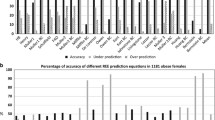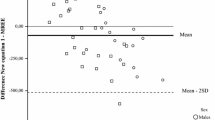Abstract
The objectives of the present study were to develop and cross-validate new equations for predicting resting energy expenditure (PREE) in severely obese Italian males, and to compare their accuracy with those of the Harris-Benedict, WHO/FAO/UNU, Huang, Owen, Mifflin, Livingston, Nelson, Bernstein, and Cunnimgham equations in order to predict resting energy expenditure (REE), using the Bland-Altman method. One hundred and sixty-four severely obese males [mean body mass index (BMI): 45.4 kg/m2; 50.2% fat mass), aged 20 to 65 yr participated in this study. REE was measured by indirect calorimetry and body composition by bioelectrical analysis. Equations were derived by stepwise multiple regression analysis using a calibration group and tested against the validation group. Two new specific equations, based on anthropometric [REE=Weight × 0.048 + Height × 4.655 − age × 0.020 − 3.605 (R2=0.68, SE=1.14 MJ/d)] or body composition parameters [REE=fat free mass (FFM) × 0.081 + fat mass (FM) × 0.049 − age × 0.019 − 2.194 (R2=0.65, SE=1.15 MJ/d)], were generated. Mean PREE were not different from the mean measured REE (MREE) (<1%, p<0.001), REE being predicted accurately (95–105% of MREE) in 66 and 62% of subjects, respectively. The Harris-Benedict, WHO/FAO/UNU, Huang and Owen equations showed mean differences lower than 5% and PREE was accurate in less than 30% of subjects. The Mifflin, Livingston, and Nelson equations showed a mean PREE underestimation >7% (p<0.001) and PREE was accurate in less than 25% of subjects. The Bernstein and Cunningham equations showed a greater PREE underestimation (>22%, p<0.001) in more than 85% of subjects. The new prediction equations allow an accurate estimation of REE in groups of severely obese males and result in lower mean differences and lower limits of agreement between PREE and MREE than the commonly used equations.
Similar content being viewed by others
References
James PT, Leach R, Kalamara E, Shayeghi M. The worldwide obesity epidemic. Obes Res 2001, 9 (Suppl 4): 228S–33S.
Mokdad AH, Ford ES, Bowman BA, et al. Prevalence of obesity, diabetes, and obesity-related health risk factors, 2001. JAMA 2003, 289: 76–9.
Foster GD, McGuckin BG. Estimating resting energy expenditure in obesity. Obes Res 2001, 9 (Suppl 5): 367S–72S.
Harris JA, Benedict FG. A biometric study of basal metabolism in man. Washington, DC: Carnegie Institute of Washington, 1919.
Frankenfield DC, Rowe WA, Smith JS, Cooney RN. Validation of several established equations for resting metabolic rate in obese and nonobese people. J Am Diet Assoc 2003, 103: 1152–9.
Lazzer S, Agosti F, Silvestri P, Derumeaux-Burel H, Sartorio A. Prediction of resting energy expenditure in Italian severely obese women. J Endocrinol Invest 2007, 30: 20–7.
WHO/FAO/UNU. Energy and protein requirements: report of a joint FAO/WHO/UNU expert consultation. World Health Organ Technical Report Series 724. Geneva, Switzerland, 1985.
Huang KC, Kormas N, Steinbeck K, Loughnan G, Caterson ID. Resting metabolic rate in severely obese diabetic and nondiabetic subjects. Obes Res 2004, 12: 840–5.
Owen OE, Holup JL, D’Alessio DA, et al. A reappraisal of the caloric requirements of men. Am J Clin Nutr 1987, 46: 875–85.
Mifflin MD, St Jeor ST, Hill LA, Scott BJ, Daugherty SA, Koh YO. A new predictive equation for resting energy expenditure in healthy individuals. Am J Clin Nutr 1990, 51: 241–7.
Livingston EH, Kohlstadt I. Simplified resting metabolic rate-predicting formulas for normal-sized and obese individuals. Obes Res 2005, 13: 1255–62.
Nelson KM, Weinsier RL, Long CL, Schutz Y. Prediction of resting energy expenditure from fat-free mass and fat mass. Am J Clin Nutr 1992, 56: 848–56.
Bernstein RS, Thornton JC, Yang MU, et al. Prediction of the resting metabolic rate in obese patients. Am J Clin Nutr 1983, 37: 595–602.
Cunningham JJ. Body composition as a determinant of energy expenditure: a synthetic review and a proposed general prediction equation. Am J Clin Nutr 1991, 54: 963–9.
Sempé M, Pedron G, Roy-Pernot M-P. Auxologie: méthode et séquences. Paris: Laboratoire Théraplix, 1979.
Lukaski HC, Bolonchuk WW, Hall CB, Siders WA. Validation of tetrapolar bioelectrical impedance method to assess human body composition. J Appl Physiol 1986, 60: 1327–32.
Das SK, Roberts SB, Kehayias JJ, et al. Body composition assessment in extreme obesity and after massive weight loss induced by gastric bypass surgery. Am J Physiol Endocrinol Metab. 2003, 284: E1080–8.
de Weir JB. New methods for calculating metabolic rate with special references to protein metabolism. J Physiol 1949, 109: 1–9.
Bland JM, Altman DG. Statistical methods for assessing agreement between two methods of clinical measurement. Lancet 1986, 1: 307–10.
Phang PT, Rich T, Ronco J. A validation and comparison study of two metabolic monitors. JPEN J Parenter Enteral Nutr 1990, 14: 259–61.
Wang Z, Heshka S, Gallagher D, et al. Resting energy expenditure-fat-free mass relationship: new insights provided by body composition modeling. Am J Physiol Endocrinol Metab 2000, 279: E539–45.
Miller AT Jr, Blyth CS. Lean body mass as a metabolic reference standard. J Appl Physiol 1953, 5: 311–6.
Horgan GW, Stubbs J. Predicting basal metabolic rate in the obese is difficult. Eur J Clin Nutr 2003, 57: 335–40.
Leibel RL, Rosenbaum M, Hirsch J. Changes in energy expenditure resulting from altered body weight. N Engl J Med 1995, 332: 621–8.
Feurer ID, Crosby LO, Buzby GP, Rosato EF, Mullen JL. Resting energy expenditure in morbid obesity. Ann Surg 1983, 197: 17–21.
Elia M. Organ and tissue contribution to metabolic rate. In: Kinney MJ, Tucker HN, eds. Energy Metabolism: Tissue Determinants and Cellular Corollaries. New York: Raven Press, 1992: 61–79.
Author information
Authors and Affiliations
Corresponding author
Rights and permissions
About this article
Cite this article
Lazzer, S., Agosti, F., Resnik, M. et al. Prediction of resting energy expenditure in severely obese Italian males. J Endocrinol Invest 30, 754–761 (2007). https://doi.org/10.1007/BF03350813
Accepted:
Published:
Issue Date:
DOI: https://doi.org/10.1007/BF03350813




